
| About Chez-Nous A North Dakota Story about a Family's life in Sykeston and other small towns 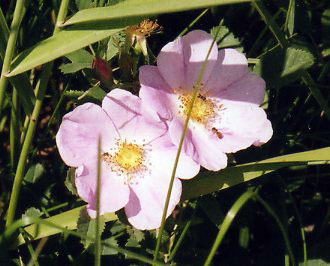 North Dakota Wild Prairie Rose at the Busch farm July 8, 2005  Cottonwood tree at the ND farm Sep 2005. Click here for message. About Chez-nous Inaugurated May 4, 2002 Comments welcome: dick_bernard@msn.com This home page celebrates the two cultural heritages of this site owner: German and French-Canadian. Chez Nous (pronounced "shay new") means "our place" or "our home" in the French of my French-Canadian ancestors, who came to what was to become Quebec between the early 1630s and the early 1700s. This is my father Henry's family - all French-Canadian. 'Chez nous' connotes family, community, warmth, welcoming and all the positive characteristics of people together, regardless of nationality. Stories and photos of one of the main branches of this French-Canadian family, the Collette's, and their migration from Quebec to what was to become Minneapolis in the 1860s, and then to northeast North Dakota at the end of the 1870s, are easily accessible at the La Societe section of this site. Also accessible at La Societe is a great history of the French Canadians generally, by Dr. Remi Roy, a descendant of Collette's. The home depicted in the painting, is the North Dakota farm home where my mother, Esther Busch, was born in 1909. Esther's ethnic heritage was 100% German. Most of her grandparents were born in Germany, and came to southwest Wisconsin, near Dubuque IA, from the 1850s and into the early 1870s. Her parents, Ferdinand Busch and Rosa Berning, grew up on neighboring farms, and after their marriage February 26, 1905, moved to a farm on never plowed south-central North Dakota soil. A year and a half later, November 13, 1906, their respective brother and sister, August Berning and Christina Busch, married and made their home on an adjoining farm in North Dakota. Later, another Busch and another Berning sibling moved to this part of North Dakota as well.  Some photos of the ND Busch farm follow this text. Photos from visits to Germany 1954 and 1998 are here. Stories of the ND Busch and Berning families are accessible here. Additional albums of August and Christina Berning family here and Busch farm scenes here. Busch-Berning Scenes in Wisconsin The Busch home evokes rural life. Nine siblings were born in this home - not an unusual number in the early days. Thirteen children were born to the Bernings. Of the 22 children in all, 19 lived long lives, perhaps a little unusual for the times, when infant mortality was very high. The neighboring Busch and Berning places a mile apart were busy country places, farmed in the early years with horse-drawn implements. Those who lived here were fed with produce, meat and milk produced on the farm. Those who crossed the threshold of these homes were hard workers. Their faith was important to them. Near these homes were large gardens. Apples and other prairie fruits grew here. Most of the garden produce was for home use, consumed fresh, or canned. Chickens were raised, and often geese roamed the yard. There were pigs, and sheep and cows and horses. And, of course, there were always cats and dogs. The main source of income was small grains like wheat, raised for sale, and other grains like oats, barley, flax and millet. In more recent years, corn, soybeans and sunflowers have been common crops. Music filled this home. Grandfather farmed by day, played violin by night and had his own band for the numerous country dances held in his area. A piano was part of the furniture by the late 1920s. Everyone sang. This was a space filled with music, after a hard day at work in the fields, or in the barn, milking cows. Visitors were frequent and visits often ended with a group photograph. This home was also filled with literature of the times. This place existed long before radio, or television or the internet. But those who dwelled within loved learning. Grandfather Busch earned patents for two inventions developed on this farm. Six of the eight surviving siblings went on to college. In all, a total of eight children and in-laws became public school teachers. Welcome to Chez-Nous.net. Dick Bernard 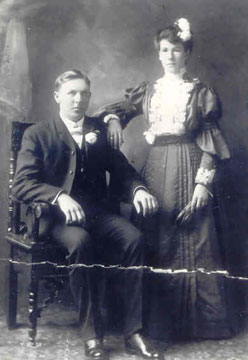 Ferdinand (Fred) Busch (24) and Rosa (Rose) Berning (21) (photo above) were married at St. Joseph's church, Sinsinawa WI, February 26, 1905. Immediately thereafter they moved to a newly constructed farm home on the treeless prairie between the hamlets of Berlin and Grand Rapids about 60 miles southeast of Jamestown ND. They lived the remainder of their long lives at the ND farm. They were part of large families who grew up on neighboring farms just east of Louisburg WI, a few miles northeast of Dubuque IA. About a year later, their siblings Christina Busch and August Berning married at Kieler WI, and moved to the same area of ND, soon settling on a farm adjoining the Busch's. Ferdinand's brother, Leonard and wife Stella, and Rosa's sister, Helena, (Lena) also moved to the same general area of North Dakota. At some point, Lena married Art Parker, and they became the first caretakers of the Grand Rapids Memorial Park not long after WWI ended. After a few years on the prairie, Leonard and Stella moved back to Dubuque where they lived the rest of their lives; August and Christina lived at their ND farm till 1920, then moved back to Dubuque, till the effects of the Great Depression drove them back to their ND farm in 1933. They lived the rest of their lives at the farm. Rose and Fred had nine children; Tina and August had twelve; Stella and Leonard had two; and Lena and Art did not have children. 
A very early photo, perhaps 1906 or 1907, of the Ferd and Rosa Busch farm, viewed from the south at about harvest time. Note especially the shocks of grain prepared for threshing; the location of the old barn, and the location of the cook house on the west side of the home, which was later attached to the east side of the home and became the kitchen. It is unknown who is pictured in the photo. 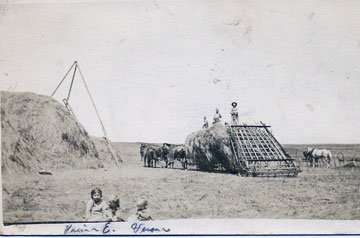 Making hay at the Busch farm in 1913. We presume the date of the photo is 1913, since Verena Busch, shown here with older sisters Lucina and Esther, was born in 1912. 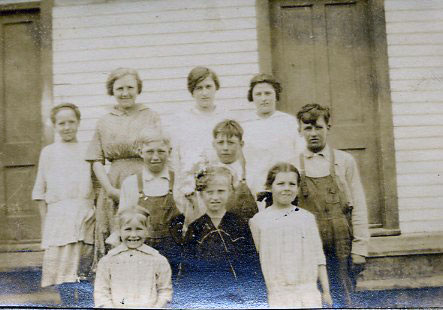
The Henrietta School all-class photo in 1915, with teacher Dorothy Gates. In the first row, from left, are Esther Busch, Irene Berning and Lucina Busch. The country school was on the property of the nearby John Schober farm, nearly a mile walk cross country for the Busch's, and nearly two miles for the Berning's. 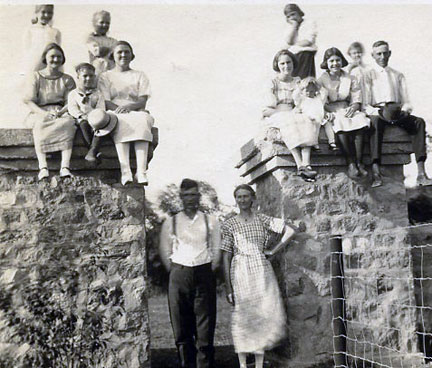 This photo is undated, but certainly at the entrance of the then-new Veterans Memorial Park near Grand Rapids ND, most likely in the summer of 1920. Standing in the entrance are Art and Lena (Berning) Parker, park caretakers. The others in the photos are most certainly members of the Busch or Berning families, perhaps including visitors from Wisconsin. The man sitting atop the corner post at right may be Leonard Busch. 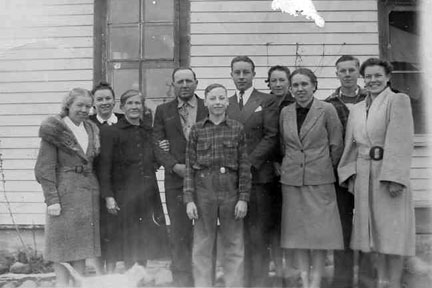 The Busch family outside their rural Berlin, North Dakota farm home, in January 1943, before their son and brother George left for his assignment as a naval officer aboard the USS Woodworth in the Pacific. Verena, who died in 1927 at age 15, is the only family member not pictured. All the children were born in this farm home. From left: Mary, Florence, Rosa and Fred, Art, George, Edithe, Esther, Vince and Lucina. In an era where college education was not the norm, all but two of the surviving children went on to college: five became public school teachers, and one became an electrical engineer. Four graduated from Valley City Normal, one graduated from Mayville Normal, and the other went to Wahpeton Science and the University of North Dakota.  The last known photo of Ferd and Rosa Busch family, July 29, 1965. Ferd Busch passed away in March, 1967, three weeks after the couple celebrated their 62nd wedding anniversary. They had lived their entire married life in the same farm home. Three of the siblings remain as of December, 2004.  In the yard of the farm home following the funeral for Grandma Rosa Busch in August 1972. Her husband, Grandpa Ferdinand, died in 1967. They had been married 62 years, their entire married life lived in this farm home.  The Ferd and Rosa Busch farm viewed from the southwest in the early 1950s. At center left in the picture is the old chicken coop; at center right, the garden and lane from the pasture to the barn. The original 1905-era barn would have been to the left of the windmill. The wind-charger (for electricity generation) is to the left of the house, and the essential outhouse is off the photo in the far northwest corner (left) of the yard surrounding the house. Along with the house, the wooden granary and lean-to to the east (center right) of the house, was a shop for Grandpa, and a place to park a single car or truck. Rural electrification did not come to the farm until the late 1940s, and even after that, the glass storage batteries charged by the wind-charger were a reserve in case of power failure. | ||||||||||||||||||||||||||||||||||||||||||||||||||||||||||||||||||||||||||||||||||||||||||||

